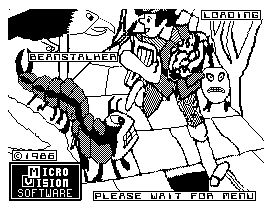Retro Replay Review
Gameplay
Beanstalker borrows its core mechanics from the classic Lode Runner formula, but wraps them in a fairy-tale veneer. You control a diminutive character who scampers across ladders and platforms, collecting all items on a screen before a shaft-style ladder appears to whisk you to the next challenge. Rather than simply avoid hostile creatures, you strategically dig holes in the ground to trap mice, worms or spiders and then climb past them. This simple digging mechanic creates surprising depth when you combine it with tight platform placements and ever-present time pressure.
(HEY YOU!! We hope you enjoy! We try not to run ads. So basically, this is a very expensive hobby running this site. Please consider joining us for updates, forums, and more. Network w/ us to make some cash or friends while retro gaming, and you can win some free retro games for posting. Okay, carry on 👍)
One of the most compelling aspects of Beanstalker’s gameplay is its steady escalation of difficulty across 60 unique screens. Early levels ease you in with generous platform spacing and slow enemies, but by screen 30 and beyond you’ll encounter more aggressive critters, tighter corridors, and multi-stage puzzles that demand precision and planning. Each level feels handcrafted, with distinct layouts that challenge you to balance speed, foresight and the occasional retreat to a safe platform.
The inclusion of a password-protected level editor significantly extends the playtime. After you’ve conquered the built-in screens, you can craft your own beanstalked challenges or tackle fan-made courses shared via Dragon user groups. While entering and managing passwords can be a bit clunky on the Dragon hardware, the simple interface and immediate testing of your creations more than makes up for it. For puzzle fans, this addition turns Beanstalker from a one-off diversion into a sandbox of design and discovery.
Graphics
Graphically, Beanstalker runs in monochrome high resolution on the Dragon platform, favoring crisp lines and clear silhouettes over flashy colors. This choice works in its favor: the tiny sprites are rendered with surprising detail, from your hero’s jaunty step animation to the scuttling gait of the smallest worm. Platforms and ladders are drawn with solid black lines on a white background, ensuring every gap and foothold is instantly readable, even during frantic escapes.
While some players may miss the vibrant palettes of console counterparts, the stark monochrome presentation lends Beanstalker a minimalist charm. Backgrounds remain uncluttered, so you’re never distracted by extraneous visuals. The screenbook changes its style subtly from level to level—sometimes adding ornamental borders or thematic flourishes that nod to the Jack and the Beanstalk origins—giving the impression of variety without sacrificing clarity.
Animation is where the game truly shines. Roy Coates’s experience with Manic Miner and Jet Set Willy shows through in the fluid motions of all on-screen characters. Even the enemy spiders have a distinctive leg-scuttling cycle, while your own protagonist bounces with a spring in his step. This attention to small details elevates the overall presentation, making monochrome graphics feel lively and engaging rather than merely functional.
Story
Beanstalker takes its inspiration from the age-old tale of Jack and the Beanstalk, though it never attempts to retell the entire saga in cutscenes or extended text dumps. Instead, the narrative is distilled into a brief setup: you ascend a magical stalk in search of hidden treasures, evading creatures that have made each level their lair. This pared-down approach keeps the focus firmly on gameplay but gives just enough context to justify your ascent through the screens.
Despite the minimal exposition, the game’s theme seeps into the level design. Certain screens incorporate giant beanstalk vines twisting in the background or platforms that resemble thick stalk segments, reinforcing the fairy-tale atmosphere. A handful of later levels even introduce silhouette shapes of looming giants in the distance, adding a subtle narrative heartbeat to the proceedings and hinting at a final confrontation beyond mere treasure collection.
What Beanstalker lacks in cutscene drama, it makes up for with environmental storytelling. Enemy variety corresponds loosely to the folklore theme—mice and worms suggest a nature-reclamation motif, while spiders evoke the creeping dangers of a forgotten castle in the clouds. Roy Coates’s roots in the golden age of platformers ensure that story never outweighs fun, but the clever integration of thematic touches gives the game a unifying identity.
Overall Experience
Beanstalker offers a polished slice of retro puzzle-platforming that will appeal to fans of Lode Runner, classic Dragon titles and anyone who appreciates tight controls and level-based progression. Its sixty handcrafted screens strike a balance between gradually increasing challenge and moments of pure, satisfying mastery. Even seasoned puzzle enthusiasts will find new wrinkles in the digging-and-climbing interplay, while newcomers can ease in at their own pace.
The password-protected level editor is the standout feature for replay value, transforming Beanstalker from a finite adventure into an open‐ended creation kit. Sharing and tackling custom levels keeps the community engaged far beyond the initial playthrough, and the simplicity of the editor belies the complexity of puzzles you can build. It’s a forward-thinking inclusion for a game of its era.
While the monochrome visuals may feel austere to players accustomed to color-rich modern titles, the detailed sprite work and fluid animations more than compensate. The story framework is light but delightful, evoking the spirit of Jack’s legendary climb without bogging down the action. All told, Beanstalker is a clever, well-crafted homage to classic platformers—ideal for retro enthusiasts, puzzle lovers and anyone seeking a sturdy challenge on the Dragon system.
 Retro Replay Retro Replay gaming reviews, news, emulation, geek stuff and more!
Retro Replay Retro Replay gaming reviews, news, emulation, geek stuff and more!








Reviews
There are no reviews yet.